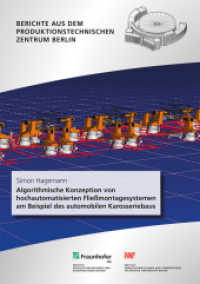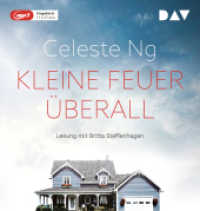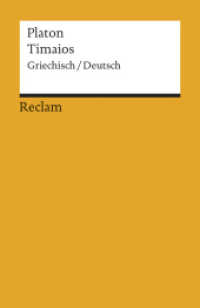- ホーム
- > 洋書
- > ドイツ書
- > Mathematics, Sciences & Technology
- > Medicine & Pharmacy
- > general survey & lexicons
Full Description
This book introduces a quality of life index that compares the intra-urban particularities of 23 cities in the Argentine Republic. Integrating demographic size, functional specialization, and regional location, the chapters employ a standard set of variables to assess socioeconomic and environmental inequality and wellbeing.
A result of collaboration between 33 contributors from institutions around the country, the book provides a rich assessment of the mechanisms and processes by which the residential areas of Argentinian cities form, change, develop, and decline. Consistent measures of education, health, housing, and environmental wellbeing allow for deep examinations of each area and meaningful comparisons between them.
The book also explores patterns that recur in multiple cases. Redevelopment and renewal processes in central and old areas of cities can lead to the creation or reenergization of modern, high-density neighborhoods that, benefitting from new construction and integrated commercial and service areas, exhibit high quality of life indices. Urban expansion stands out as a process that often results in or reinforces socio-spatial segregation: New, exclusive, low-density residential neighborhoods with single-family homes and green areas tend to have a high level of quality of life, thanks to good education, health services, housing, and natural amenities. In contrast, low-income neighborhoods with precarious housing, limited access to health and education services, and unfavorable environments exhibit lower quality of life measures. Increasingly common gated communities—with private security, exclusive services, and (internally) shared recreational spaces—reinforce this pattern of segregation.
Analyzing the quality of life in different Argentinian cities is important to understanding the living conditions of the inhabitants, identifying areas for improvement, and supporting the development of inclusive and sustainable policies. These measurements can facilitate more just and prosperous environments for all citizens.
Contents
Chapter 1: Quality of life in Argentine cities: a general review.- Chapter 2: Greater Neuquén.- Chapter 3: Comodoro Rivadavia.- Chapter 4: San Carlos de Bariloche.- Chapter 5: Puerto Madryn.- Chapter 6: Viedma-Patagones.- Chapter 7: Greater Córdoba.- Chapter 8: Greater Santa Fe.- Chapter 9: Greater Rosario.- Chapter 10: Greater La Plata.- Chapter 11: Mar del Plata.- Chapter 12: Greater Paraná.- Chapter 13: Tandil.- Chapter 14: Luján.- Chapter 15: Greater Mendoza.- Chapter 16: Greater San Juan.- Chapter 17: Greater San Luis.- Chapter 18: Greater San Miguel de Tucumán.- Chapter 19: Greater Salta.- Chapter 20: Greater Santiago del Estero-La Banda.- Chapter 21: Greater Resistencia.- Chapter 22: Corrientes.- Chapter 23: Posadas.- Chapter 24: Formosa.- Chapter 25: Quality of urban life in argentine cities: an integrative analysis.








